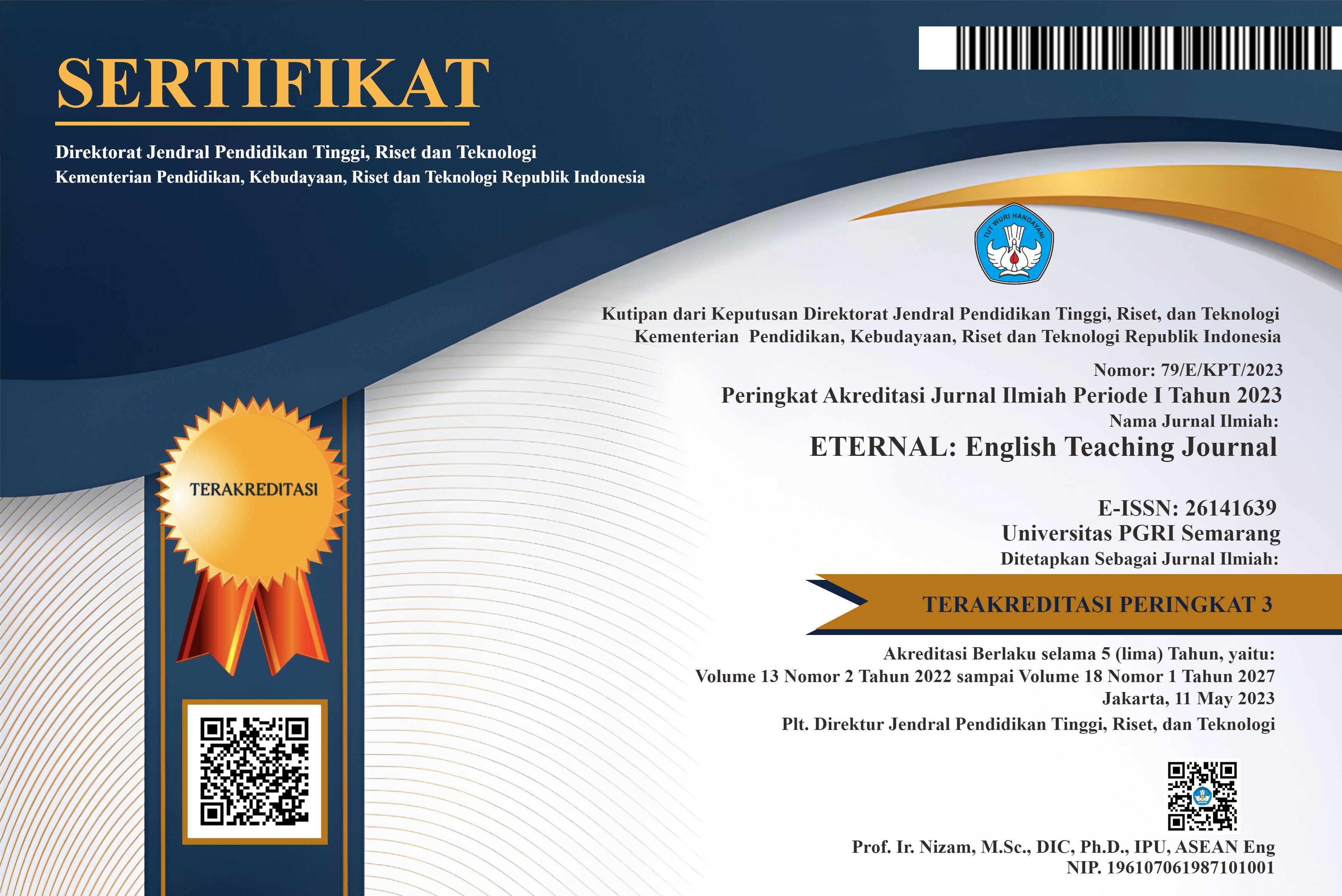Shadowing Technique to Improve the Students’ Pronunciation Ability in Narrative Text
DOI:
https://doi.org/10.26877/eternal.v16i1.1122Keywords:
Shadowing Technique, Improve, Pronunciation, Narrative TextAbstract
This research is based on a study that looks at how shadowing technique can help eighth grade students at SMPN 37 Semarang improve their pronunciation. The purpose of this study was to find out how shadowing technique can improve pronunciation in one type of texts, a narrative text. This study aims to determine the following: (1) students' pronunciation achievement in narrative text before using the shadowing technique; (2) students' pronunciation achievement in narrative text after using the shadowing technique; and (3) to find out whether there is a significant improvement in students' English pronunciation in narrative text through the use of shadowing technique. The methodology of this study includes pre-experimental research. The pre-test and post-test are used in this study are how the researcher gathers data. In the data analysis, the researcher employs statistical computation using SPSS. This study used one eighth-grade class in SMPN 37 Semarang as its sample. There are 33 students in the class. The research’s data was gained from the students’ voice recordings. It is therefore evident from the pre- and post-test means. The pre-test outcome is 61.82. After receiving the treatment, the post-result is 90.85. Furthermore, the outcome of the hypothesis indicated that Ha is accepted. T-count exceeded T-table (17.693 > 1.694), which suggests that the shadowing technique noticeably improved pronunciation.
References
Agustina, A., & Cahyono, S. P. (n.d.). Genre Analysis of Online Private Class During the COVID-19 Pandemic.
Ambarini, R. (n.d.). The Effectiveness of Communicative Purpose Based Approach to Improve Speaking Skills in EAP Setting: A Case Study.
Ambarini, R., Zahraini, D. A., Yulianti, F., & Prayogi, I. (2022). The Linkage of Online Microteaching Programs Helping Prospective Teacher Students Practice Reflective Thinking about Teaching Skills.
Arik Diantoro, Tri Mulyati, & Abdul Halim. (2021). The Effect of Mobile Legend Game on Vocabulary Mastery of the Tenth Grade Student of SMAN 1 Cluring. LUNAR, 4(1), 128–133. https://doi.org/10.36526/ln.v4i1.1442
Ary, D. et al (2010). Introduction to research in education. United State: Wardsworth.
Brown, H. (2000). Principles of Language Learning and Teaching Fifth Edition. San Francisco University.
Burns, A. (2003). Clearly speaking: pronunciation in action for teachers. National Center for English Language Teaching and Research, Macquaire Universaity, Sydney NSW 2109.
Cahyono, A. (2022). The Implementation Of Shadowing Technique In Practicing English Speaking Performance At The Eleventh Grade Students Sman 1 Tawangsari Sukoharjo In Academic Year 2021/2022. Universitas Islam Negeri Raden Mas Said Surakarta. Sukoharjo: Digital Repository Universitas Islam Negeri Raden Mas Said Surakarta.
Chi, H. D. (2021). The Implementation Of Shadowing Technique In English Language Learning And Teaching. Journal of Transportation Science and Technology, 4-6.
Coniam, D. 2002. Technology as an awareness raising tool for sensitising teachers to features of stress and rhythm in English. Language Awareness, 11.
Defrioka, A. (2014). Retelling: An alternative Strategy in Teaching Reading Narrative Text. SELT, 47.
Djiwandono, M. S. 2008. Tes Bahasa: Pegangan Bagi Para Pengajar Bahasa. Malang. PT Macanan Jaya Cemerlang.
Djuharie, Otong Setiawan. 2017. Genre. Bandung: Yrama Widya.
Feez, S., and Joyce, Helen de Silva. (2000). Creative writing skills. Albert Park, Victoria: Phoenix Education.
Foote, J. A., & McDonough, K. (2017). Using shadowing with mobile technology to Improve L2 Pronunciation. Journal of Second Language Pronunciation.
Garba, T. (n.d.). Research Methodology: A Quantitative Approach. Research Methodology.
Hamada, Y. (2018). Shadowing for Pronunciation Development: Haptic-Shadowing and IPA-Shadowing. Asia TEFL, 167-176.
Harmer, J. (2004). The Practice of English Language Teaching. England: Longman.
Hastatriningtyas, L., Hidayat, N., & Ambarini, R. (n.d.). THE STUDY OF MORAL VALUES IN “MALEFICENT” MOVIE AND ITS CONTRIBUTION TO DRAMA TEACHING.
Hastuti, D. 2010. Narrative Versus Recount. Jakarta Timur:PT. Multazam Mulia Utama.
Huyen, N. T., Thao, T. N., Dung, T. T., & Trang, N. T. (2020). SHADOWING AND INTERPRETING PERFORMANCES. VNU Journal of Foreign Studies, 131-132.
Kadota, S., & Tamai, K. (2004). Ketteiban, Eigo Shadowing (The Definitive Edition English Shadowing). Tokyo: CosmoPier Publishing Company.
Lestari, R., Harahap, A. L., Munthe, D., Rusli, M., Rambe, S. A., & Harahap, N. (2024). The Improving Of Students English Pronunciation Skill By Using English Pronunciation Digital At Man Labuhanbatu, SUMUT. 06(02).
Maya, L., & Iskandar, I. (2022). English Language Teaching Praxes and Policies in Indonesia: A Critical Review. ICoTE, 51.
Morley, J. (1991). The pronunciation component in teaching English to speakers of other languages. TESOL Quarterly 25
Natasia, G., & Angelianawati, L. (2022). Students’ Perception of Using Storytelling Technique to Improve Speaking Performance at SMPN 143 Jakarta Utara. JET (Journal of English Teaching), 8(2), 282–292. https://doi.org/10.33541/jet.v8i2.4063
Nurhayati, D. A. (2018). ENGLISH PHONETICS Theory and Practices. Tulungagung: Akademia Pustaka.
Palupi, D., Prasetyaningsih, E. T., & Bilandari, S. (2022). IMPROVING YOUNG LEARNERS’ PRONUNCIATION SKILL THROUGH SONGS. ETERNAL (English Teaching Journal), 13(1), 21–31. https://doi.org/10.26877/eternal.v13i1.10512
Prashant, P. D. (n.d.). IMPORTANCE OF PRONUNCIATION IN ENGLISH LANGUAGE COMMUNICATION.
Seferoğlu, G. (2003, October). Recent trends in teaching pronunciation: to what extent is diversity acceptable? Paper presented at Multiculturalism in ELT Practices: Unity & Diversity, an international conference by Turkey-INGED, Romania-BETA, Israel-ETAI & Greece-TESOL, Baskent University, Ankara, Turkey.
Siahaan, S., And K. Shinoda. 2016. Generic Text Structure. Yogyakarta: Graha Ilmu.
Sudarmo, S. (2021). The Importance of Speaking in English as a Foreign Language between Skillful and Thoughtful Competencies: Studying Sociolinguistics Perspectives. Linguistics and Culture Review, 5. https://doi.org/10.37028/lingcure.v5nS1.1321
Sugiyono, 2012. Metode Penelitian Bisnis. Alfabeta, Bandung.
Tamai, K. (1992). Follow-up no chokairyoku kojo ni oyobosu koka oyobi “follow-up” noryoku to chokairyoku no kankei. dai 4 kai “Eiken” kenkyu josei hokoku [The effect of follow-up on listening comprehension]. STEP Bulletin, 4.
Tamai, K. (2005). Shadoingu no Koka ni Kausuru Kenkyu (Research on the Effectiveness of Shadowing as a Teaching Method of Listening Skills).
Ulfa, S. T., & Fatimah, S. (2019). Shadowing As A Technique To Practice English Pronunciation During Classroom Oral Activities In Senior High School. Journal of English Language Teaching.
Utami, H. S., & Morganna, R. (2022). Improving Students’ English Pronunciation Competence by Using Shadowing Technique. ENGLISH FRANCA: Academic Journal of English Language and Education.







